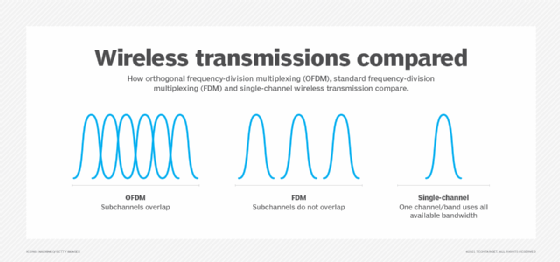OFDMA (orthogonal frequency-division multiple access)
What is OFDMA (orthogonal frequency-division multiple access)?
Orthogonal frequency-division multiple access (OFDMA) is a technology of Wi-Fi 6 (802.11ax) that lets access points serve multiple clients at the same time. OFDMA follows a set of rules created for the transmission of data between multiple terminals or clients over a transmission medium. The terminal could be any device at the end of a transmission channel, such as a computer or phone, and the medium could be a wireless network.
Orthogonal frequency-division multiplexing is a signal modulation technique that uses multiple subcarriers within the same communications channel. These subcarriers are closely spaced, transmit in parallel and carry low-bit rate data. The use of multiple subcarriers makes the technique resilient to selective fading and interference as well as provides fairly high spectral efficiency.
OFDM is itself based on frequency-division multiplexing and was commonly used in the past for cellular networking, broadcast media and older Wi-Fi standards like IEEE 802.11ac (Wi-Fi 5). OFDMA is a variant of the OFDM scheme. Specifically, it is a multi-user variant of OFDM, meaning it allows for multiple access and simultaneous data access for different users. This form of communication is an upgrade to both FDM and OFDM.

How OFDMA works
Traditional multiplexing technologies used analog modulation. In contrast, OFDMA uses carrier signal waves, called subcarriers, to move small bits of information in a more streamlined fashion. These subcarriers may be data subcarriers, reference-signal subcarriers or null subcarriers. Only the data subcarriers are used for data transmission. The channel is split into smaller frequencies known as resource units (RUs), so wireless carriers can efficiently occupy and use the frequency bands they are licensed to use.
By assigning subsets of time-frequency RUs to multiple users (e.g., access points), OFDMA allows users to communicate with multiple clients and simultaneously transmit data. The RUs are assigned depending on the bandwidth needed by the user as well as other factors, such as quality of service requirements, packet size and device constraints. Users may also have varying usage patterns or data loads but they are all accommodated in OFDMA because of the use of multiple closely-spaced subcarriers and flexible RU allocation.
An example of how OFDMA works is when two phones send data over the same phone line. A time-interval may be assigned to each phone so that they will take turns sending their signal over the line at their assigned intervals. However, these time frames are imperceptibly small, making it seem that the data transfers by both phones are happening simultaneously and seamlessly.
OFDMA and FDM
FDM is a communications technology in which multiple signals are combined and then transmitted over a single channel. The total available bandwidth is divided into multiple non-overlapping frequency bands. Overlapping is prevented due to the presence of guard bands, which refer to unused frequencies that separate the assigned bands. At the sending end, the modulated signals are combined with a multiplexer. The individual signals are then extracted from the combined signal at the receiving end using a demultiplexer.
OFDMA is an updated version of FDM that parallels internet carriers' switch to Wi-Fi 6 wireless as well as the upgrade of phone carriers upgrading to 4G and 5G LTE. Instead of the traditional analog modulation used in multiplexing, OFDMA uses carrier signal waves as subcarriers to move small bits of information in a more streamlined fashion.
OFDMA in Wi-Fi 6
OFDMA is one of the technology enhancements introduced in Wi-Fi 6. Wi-Fi 6 offers speeds of up to 9.6 Gbps, a sharp improvement over the 3.5 Gbps available in Wi-Fi 5. The higher speed can be split across multiple devices, so each device can benefit from potentially higher speeds.
With the introduction of OFDMA, Wi-Fi 6 increases network capacity to mitigate the access issues that are common when multiple Wi-Fi devices are active on a single network. Regardless of how many devices are added to the network or their data demands, OFDMA ensures strong connections and uninterrupted access over Wi-Fi 6, as well as lower latency for real-time applications like audio/video conferencing and online gaming. OFDMA can also increase the maximum throughput of a Wi-Fi network and improve the power efficiency of Wi-Fi-enabled mobile devices.
Advantages and disadvantages of OFDMA
One of the biggest advantages of OFDMA transmission is that it doesn't suffer from intracell interference. That said, OFDMA is somewhat prone to intercell interference, which can lead to degradation of signal quality. However, it is possible to mitigate intercell interference using techniques such as packet scheduling, frequency reuse and interference coordination.
Apart from low intracell interference, other advantages of ODFMA include the following:
- Higher diversity frequency.
- More efficiently packed subcarriers in the frequency spectrum, ensuring optimal spectral efficiency.
- More flexibility, as channels and subchannels can be toggled on and off.
- Provision for multiple independent channels.
- Better coverage over networks.
Owing to these advantages, OFDMA is frequently used in wireless LAN (Wi-Fi), long-term evolution (LTE or 4G) and WiMAX systems.
Potential disadvantages of OFDMA include the following:
- The diversity of frequencies is conditional on how subcarriers are assigned to users, which can become complex.
- It requires extra power because it is always on and ready to send a transmission.
- It has a higher sensitivity than other channel types to frequency offset.
Learn more about Wi-Fi 6 and how OFDMA works. See the difference between OFDMA vs. MU-MIMO in Wi-Fi 6. Explore five benefits of Wi-Fi 6 for enterprise networks. Check out the differences between Wi-Fi 6 vs. Wi-Fi 6E and the Wi-Fi 6 glossary of 12 important terms and phrases.






